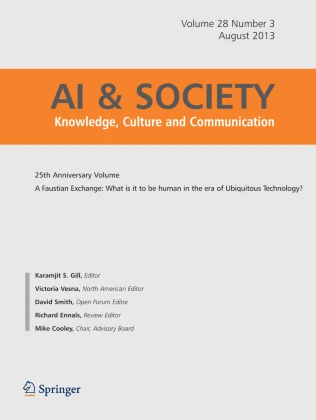Publications
Books, articles, and reports published by Digital Life Institute members.
Augmenting User Experience Design with Multimodal Generative Artificial Intelligence: A Study of Technical Communication Students
Jialei Jiang and Gustav Verhulsdonck
Article: This qualitative study explores the integration of multimodal generative artificial intelligence (GenAI) tools, including FigJam AI and Figma AI plugins, into technical communication students’ design thinking stages of user experience (UX) design. Findings from students’ AI statements and focus group discussions indicate the positive roles of GenAI in defining and designing and identify its limitations in empathizing and evaluating. The study provides practical implications for scholars and practitioners seeking to enhance UX design with GenAI.
Access HereOlder People’s Ethical Framing of Autonomy in Relation to Current and Future Consumer Technologies: The Case of Socially Assistive Robots
Andrea Slane, Isabel Pedersen
Journal Article: Development of Socially Assistive Robots (SARs) and other assistive smart technologies is commonly justified by casting aged care as approaching a crisis point, due to an aging population and ensuing strain on healthcare systems. Combined with older people’s overwhelming wish to avoid more formal care contexts for as long as possible, this confluence of factors positions SARs as means to extend independent living, and so has inspired commercial developers to market their devices directly to older consumers. Preserving respect for the ethical principle of autonomy has been central to discussion of SARs in aged care settings, some of which incorporates the ethical views of older people. Since consumer SARs are claiming to integrate into older people’s digital device consumption practices, this article argues that more attention needs to be paid to what autonomy means to older peoples as digital technology consumers. Through analysis of marketing materials and two qualitative studies focused on how older people think about potential use of consumer SARs, the participants’ ethical reasoning on autonomy is revealed to be informed by a sociotechnical discourse that on the one hand aligns with common cultural imaginaries of aging, but on the other displays a range of orientations towards consumer digital technology use on individual, collective and societal levels. The article contributes to the field a novel and nuanced understanding of the value of autonomy held by older people and their ethical reasoning concerning future consumer information technologies such as SARs.
International Journal of Social Robotics, Volume 16, pages 2277–2296, (2024)
Access HereWork in the Digital Media and Entertainment Industries A Critical Introduction
Tanner Mirrlees
Book: This book is a first-of-its-kind critical interdisciplinary introduction to the economic, political, cultural, and technological dimensions of work in the rapidly growing digital media and entertainment industries (DMEI).
Tanner Mirrlees presents a comprehensive guide to understanding the key contexts, theories, methods, debates, and struggles surrounding work in the DMEI. Packed with current examples and accessible research findings, the book highlights the changing conditions and experiences of work in the DMEI. It surveys the DMEI’s key sectors and occupations and considers the complex intersections between labor and social power relations of class, gender, and race, as well as tensions between creativity and commerce, freedom and control, meritocracy and hierarchy, and precarity and equity, diversity, and inclusivity. Chapters also explore how work in the DMEI is being reshaped by capitalism and corporations, government and policies, management, globalization, platforms, A.I., and worker collectives such as unions and cooperatives. This book is a critical introduction to this growing area of research, teaching, learning, life, labor, and organizing, with an eye to understanding work in the DMEI and changing it, for the better.
Offering a broad overview of the field, this textbook is an indispensable resource for instructors, undergraduates, postgraduates, and scholars.
Access HereBeyond Digital Literacy: Investigating Threshold Concepts to Foster Engagement with Digital Life in Technical Communication Pedagogy
Danielle Mollie Stambler, Nupoor Ranade, Daniel L. Hocutt, Stephen Fonash, Jessica Lynn Campbell, Ann Hill Duin, Isabel Pedersen, Jason Tham, Saveena (Chakrika) Veeramoothoo & Gustav Verhulsdonck
Journal Article: As digital technologies rapidly evolve, updating and enhancing models of digital literacy pedagogy in technical and professional communication (TPC) becomes more urgent. In this article, we use “digital life” to conceptualize the ever-changing ways of knowing and being in postinternet society. Using collaborative autoethnography, we investigate features of threshold concepts in TPC pedagogy that may support models of digital literacy that are resistant to tools-based definitions, foster student agency, and facilitate accessibility, equity, and justice.
This article is published in the Technical Communication Pedagogy, Technical Communication Quarterly.
Access HereData analytics for TPC curriculum
Daniel Hocutt, Nupoor Ranade, Jianfen Chen, Katlynne Davis
Despite serving as a user analysis tool for technical communicators where usability testing methods fall short, data analytics remains underdeveloped in technical and professional communication (TPC) pedagogy. In this entry, we discuss the value and means to incorporate data analytics in existing TPC courses to prepare students for the workplace, and as a way to provide an accessibility-driven framework to perform user studies through data analysis methods for practitioners.
Access HereIncorporating Human Judgment in AI-Assisted Content Development: The HEAT Heuristic
Gustav Verhulsdonck, Jennifer Weible, Danielle Mollie Stambler, Tharon Howard, Jason Tham
Journal Article: Purpose: As technical and professional communicators (TPCs) use AI to develop content, inaccuracies due to AI limitations are introduced; it is vital TPCs evaluate AI-generated content to improve accuracy and human-centeredness. In this article, we present a human-in-the-loop AI content heuristic (HEAT: Human experience, Expertise, Accuracy, and Trust) as a rating mechanism.
Method: This exploratory case study evaluated the quality of content generated by ChatGPT from the perspective of beginner TPC students. We used multiple prompting strategies asking ChatGPT to create documentation on personas using two Darwin Information Type Architecture (DITA) information types namely, concept topics and task instructions, and we evaluated the results with HEAT.
Results: HEAT had good intraclass correlation coefficient (ICC) reliability (.743 pilot; .825 for scenarios) indicating its fitness as a heuristic for evaluating generative AI output. The findings indicate that ChatGPT was generally good at writing concept topics; however, it performed less well creating step-by-step task instructions. Expert TPC input helped develop a better prompt for improved output. We also found that tokenization in ChatGPT (the way it breaks up text) has a large role in terms of noncompliance with format specifications.
Conclusion: There is a need for TPCs to (1) develop new models for AI-assisted content creation, (2) recognize the impact of different prompting strategies on developing specific structured authoring units such as concept and task topics, and (3) be aware of the limitations of AI such as ChatGPT. Human-in-the-loop quality check mechanisms, such as HEAT, can help validate and modify AI-generated content to better serve end users.
Access HereSEO as audience analysis: Accounting for algorithms in content strategy
Daniel L. Hocutt
Technical Communication, 71(3)
Access HereCompliance and enforcement in a brave new (green) world: best practices and technologies for green governance
Delon Omrow, Michelle Anagnostou, Phillip Cassey, Steven J. Cooke, Sheldon Jordan, Andrea E. Kirkwood, Timothy MacNeill, Tanner Mirrlees, Isabel Pedersen, Peter Stoett, and Michael F. Tlusty
Journal Article: International and transnational cooperation is needed to strengthen environmental governance initiatives with advanced technologies. In January 2023, Ontario Tech University hosted a symposium entitled Tech With a Green Governance Conscience: Exploring the Technology–Environmental Policy Nexus. Attendees spanned diverse disciplines, sectors, and countries, bringing unique and diverse perspectives to the technology–environmental policy nexus. Emergent themes arising from the symposium include the role of artificial intelligence in environmental governance, while eliminating the detrimental social impacts associated with these advanced technologies via algorithmic bias, misunderstanding, and unaccountability. The symposium explored the tech–society–ecology interface, such as the authoritarian intensification of digitalized environmental governance, “technocracy”, and the ethical implications of sacrificing democratic legitimacy in the face of imminent environmental destruction. Select participants (i.e., co-authors) at the symposium provided input on a preliminary framework, which led to this perspective article focused on the politics surrounding green governance in the 21st century. We conclude that while emerging technologies are being deployed to address grand environmental challenges such as climate change, biodiversity loss, and resource depletion, the use of these various technologies for progressive environmental policy development and enforcement requires co-productivist approaches to constructive technology assessments and embracing the concept of technologies of humility. This necessitates a space for dialogue, reflection, and deliberation on leading adaptive environmental governance in the face of power and politics, as we interrogate the putative neutrality of advanced technology and techno-solutionism.
Access HereToward Digital Life: Embracing, Complicating, and Reconceptualizing Digital Literacy in Communication Design
Danielle Mollie Stambler, Saveena (Chakrika) Veeramoothoo, Katlynne Davis
Journal Article: This article is the introduction to the Communication Design Quarterly special issue on digital life. It explains the exigency for this issue and details how digital literacies in technical and professional communication are complicated by emerging technologies. It also demonstrates the potential for moving toward a model of digital life as a flexible way of foregrounding and talking about the work we are all already doing to understand and improve our post-human lives.
Access HereGenerative AI Adoption in Postsecondary Education, AI Hype, and ChatGPT’s Launch
Isabel Pedersen
Journal Article: The rapid integration of generative artificial intelligence (AI) into postsecondary educationand many other sectors resulted in a global reckoning with this new technology. This paper contributes to the study of the multifaceted influence of generative AI, with a particular focus on OpenAI’s ChatGPT within academic settings during the first six months after the releasein three specific ways. First, it scrutinizesthe rise of ChatGPT as a transformative event construed through a study of mainstream discourses exhibiting AI hype. Second, itdiscusses the perceived implications of generative AI for writing, teaching, and learningthrough the lens of critical discourse analysis and criticalAI studies.Third, itencourages the necessity for best practices in the adoption of generative AI technologies in education.Keywords: AI and education, educational technologies, AI hype, ChatGPT, critical discourse analysis.
This article appears in Open/Technology in Education, Society, and Scholarship Association Journal (OTESSA Journal).
Access HereContracting out and partnering with AI
Daniel L. Hocutt, Ann Hill Duin
Intercom, 71(2), 9–13.
Access HereBringing older people’s perspectives on consumer socially assistive robots into debates about the future of privacy protection and AI governance
Andrea Slane, Isabel Pedersen
Journal Article: A growing number of consumer technology companies are aiming to convince older people that humanoid robots make helpful tools to support aging-in-place. As hybrid devices, socially assistive robots (SARs) are situated between health moni-toring tools, familiar digital assistants, security aids, and more advanced AI-powered devices. Consequently, they implicate older people’s privacy in complex ways. Such devices are marketed to perform functions common to smart speakers (e.g., Amazon Echo) and smart home platforms (e.g., Google Home), while other functions are more specific to older people, including health and safety monitoring and serving as companions to mitigate loneliness. Privacy is a key value central to debates about the ethics of using SARs in aged care, yet there has been very little interchange between these debates and the robust theoretical discussion in the legal literature about the future of privacy and AI governance. Drawing on two qualitative studies of older people’s views on consumer SARs, the paper contributes novel findings about older people’s thinking on privacy and data governance at the intersection of their experiences with present day digital technologies and projections for future AI systems, and places their views in dialogue with debates about the future of privacy protection and AI governance.
Access Here










